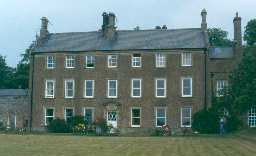Local History
Bavington (Northumberland)
The parish of Bavington lies in central southern Northumberland. It stretches from Sweethope Moss in the north-west, through the crags of Sweethope, Bavington and Throckrington, to the pastureland and parkland of Little Bavington in the south-east. The parish is rich in remains of all periods from the Bronze Age to post-medieval period. Prehistoric, medieval and post-medieval field systems and farmsteads show the importance of agriculture in the area. In addition, the presence of post-medieval and modern quarries, for whinstone and limestone, are evidence of the natural resources of the parish.
Although there may have been earlier inhabitants, the first evidence we have for human activity belongs to the Neolithic. This comes from the discovery of two polished stone axes at Throckrington and Great Bavington and a cup marked rock at Hawick. The remains of any Neolithic settlement will probably have been destroyed long ago through continuous agricultural activity in the area. With the advent of the Bronze Age comes our first evidence of prehistoric settlement at Sweethope Crags. There are comparatively few remains of Bronze Age burial cairns in the parish although scatters of undated clearance cairns on the rough grasslands in the central part of the parish may also belong to this period. A rare burnt mound attests to further Bronze Age activity.
In the Iron Age and Romano-British periods evidence of settlement is much more abundant with at least nine farmsteads identified so far. These are largely sub-rectangular or sub-circular enclosures, defined by a simple earthen bank and ditch, with the remains of houses and yards inside. Associated with some of these farmsteads are contemporary field systems.
Like many parts of Northumbria there are no monuments or finds from the early medieval period. It is only after the Norman Conquest that once again we can recognise remains of the past in the parish. Little and Great Bavington were only two of a number of villages and hamlets in the parish, including Hawick, Throckrington and Sweethope. In addition to these settlements, at least one medieval farmstead has been discovered, at the very north of the parish. The presence of individual building remains on the rough grassland in the centre of the parish suggests that this slightly elevated land was used for summer pasture and shepherds lived in these shielings.
The documentation of a fortified tower at Little Bavington in the 15th century attests to the troubled nature of the Border region at this time. A fact also suggested by the possible bastle that is reported to have stood at Throckrington.
Growing peace in the Border region through the post-medieval period is reflected in the construction of buildings such as Bavington Hall and creation of surrounding landscaped parkland in the 18th century. Families who had dwelt in the area since medieval times now felt confident enough to make large investments in non-defensive homes. As well as agriculture, evidence of other economic activities includes lead workings, a tileworks and quarries. Today the parish is still rural in character with agriculture as the mainstay.
Although there may have been earlier inhabitants, the first evidence we have for human activity belongs to the Neolithic. This comes from the discovery of two polished stone axes at Throckrington and Great Bavington and a cup marked rock at Hawick. The remains of any Neolithic settlement will probably have been destroyed long ago through continuous agricultural activity in the area. With the advent of the Bronze Age comes our first evidence of prehistoric settlement at Sweethope Crags. There are comparatively few remains of Bronze Age burial cairns in the parish although scatters of undated clearance cairns on the rough grasslands in the central part of the parish may also belong to this period. A rare burnt mound attests to further Bronze Age activity.
In the Iron Age and Romano-British periods evidence of settlement is much more abundant with at least nine farmsteads identified so far. These are largely sub-rectangular or sub-circular enclosures, defined by a simple earthen bank and ditch, with the remains of houses and yards inside. Associated with some of these farmsteads are contemporary field systems.
Like many parts of Northumbria there are no monuments or finds from the early medieval period. It is only after the Norman Conquest that once again we can recognise remains of the past in the parish. Little and Great Bavington were only two of a number of villages and hamlets in the parish, including Hawick, Throckrington and Sweethope. In addition to these settlements, at least one medieval farmstead has been discovered, at the very north of the parish. The presence of individual building remains on the rough grassland in the centre of the parish suggests that this slightly elevated land was used for summer pasture and shepherds lived in these shielings.
The documentation of a fortified tower at Little Bavington in the 15th century attests to the troubled nature of the Border region at this time. A fact also suggested by the possible bastle that is reported to have stood at Throckrington.
Growing peace in the Border region through the post-medieval period is reflected in the construction of buildings such as Bavington Hall and creation of surrounding landscaped parkland in the 18th century. Families who had dwelt in the area since medieval times now felt confident enough to make large investments in non-defensive homes. As well as agriculture, evidence of other economic activities includes lead workings, a tileworks and quarries. Today the parish is still rural in character with agriculture as the mainstay.
N12988
UNCERTAIN
Disclaimer -
Please note that this information has been compiled from a number of different sources. Durham County Council and Northumberland County Council can accept no responsibility for any inaccuracy contained therein. If you wish to use/copy any of the images, please ensure that you read the Copyright information provided.
